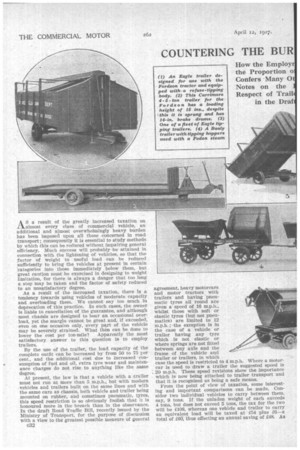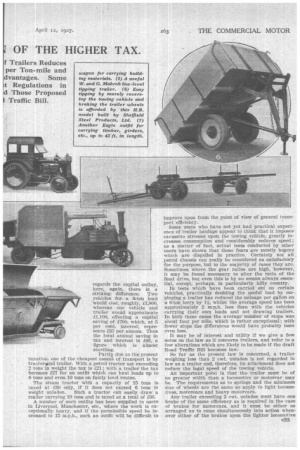COUNTERING THE BUR OF THE HIGHER TAX.
Page 54

Page 55

Page 56

If you've noticed an error in this article please click here to report it so we can fix it.
A S a result of the greatly increased taxation on 1-1-almost every class of commercial vehicle, an additional and almost overwhelmingly heavy burden has been imposea upon all those concerned in road transport ; consequently it is essential to study methods by which this can be reduced without impairing general efficiency. Much success will probably be attained in connection with the lightening of vehicles, so that the factor of weight to useful load can be reduced sufficiently to bring the vehicles at present in certain 'categories into those immediately below them, but
• great caution must be exercised in designing to weight limitation, for there is always a danger that too long a step may be taken and the factor of safety reduced to an unsatisfactory degree.
As a result of the increased taxation, there is a tendency towards using vehicles of moderate capacity and overloading them. We cannot say too much in deprecation of this practice. In such cases, the owner is liable to cancellation of the guarantee, and although most chassis are designed to bear an occasional overload, yet the margin cannot be great and, if exceeded, even on one occasion only, every part of the vehicle may be severely strained. What then can be done to Tower the cost per ton-mile? Apparently the most satisfactory answer to this question is to employ trailers.
By the use of the trailer, the load capacity of the complete outfit can be increased by from 50 to 75 per cent., and the additional cost due to increased consumption of fuel and oil, extra tyre wear and maintenance charges do not rise to anything like the same degree.
At present, the law is that a vehicle with a trailer must not run at more than 5 m.p.h., but with modern vehicles and trailers built on the same lines and with the same care as chassis, both vehicle and trailer being mounted on rubber, and sometimes pneumatic, tyres, this speed restriction is so obviously foolish that it is honoured more in the breach than in the observance. In the draft Road Traffic Bill, recently issued by the Ministry of Transport, for the purpose of discussion with a view to the greatest possible measure of general
c32
agreement, heavy motorcars and motor tractors with trailers and having pneumatic tyres all round are given a speed of 16 m.p.h., whilst those with soft or elastic tyres (but not pneumatics) are limited to 12 m.p.h.; the exception is in the case of a vehicle or trailer having any tyre which is not elastic or where springs are not fitted between any axle and the frame of the vehicle and trailer or trailers, in which case the speed is restricted to 4 m.p.h. Where a motorcar is used to draw a trailer the suggested speed is 20 m.p.h. These speed revisions show the importance which is now being attached to trailer transport and that it is recognized as being a safe means.
From the point of view of taxation, some interesting and important comparisons can be made. Consider two individual vehicles to carry between them, say, 9 tons. If the unladen weight of each exceeds 4 tons, but does not exceed 5 tons, the tax for the two will be £108, whereas one vehicle and trailer to carry an equivalent load will be taxed at £54 plus 16---a total of £60, thus effecting an annual saving of £48. As
regards the capital outlay, here, again, there is a striking. difference. Two vehicles for a 9.-ton load would cOst, roughly, £1,800, whereas one vehicle and trailer would approximate £1,100, effecting a capital saving of £700, which, at 5 per cent, interest, represents £35 per annum. Thus the total annual saving in tax and interest is £83, a figure which is almost startling.
Partly due to the present taxation, one of the cheapest means of transport is by tractor-end trailer. With a petrol tractor not exceeding 2 tons in weight the tax is £21; with a trailer the tax becomes £27 for an outfit which can haul loads up to 8 tons and even 10 tons on fairly level routes.
The steam tractor with a capacity of 15 tons is taxed at £30 only, if it does not exceed 6 tons in weight unladen. Such a tractor can easily draw a trailer carrying 10 tons and is taxed at a total of £36.
A number of such outfits has been supplied to users In Liverpool, Manchester, etc., where the work is exceptionally heavy, and if the permissible speed he increased to 12 m.p.h., such an outfit will be difficult to improve upon from the point of view of general transport efficiency.
Some users who have not yet had practical experience of trailer haulage appear to think that it imposes excessive stresses upon the towing vehicle, greatly increases consumption and considerably reduces speed; as a matter of fact, actual tests conducted by other users have shown that these fears are mostly bogeys which are dispelled in practice. Certainly not all . petrol chassis can really be considered as satisfactory for the purpose, but in the majority of cases they are. Sometimes where the gear ratios are high, -however, it may be found necessary to alter the ratio of the final drive, but even this is by no means always essential, except, perhaps, in particularly hilly country.
In tests which have been carried out on certain vehicles, practically doubling the useful load by employing a trailer has reduced the mileage per gallon on a 6-ton lorry by lii, whilst the average speed has been approximately 2 m.p.h. less than with the vehicles carrying their own loads and not drawing trailers. In both these cases the average number of stops was about four per mile, which is rather exceptional; with fewer stops the differences would have probably been even less. • It may be of interest and utility if we give a few notes on the law as it concerns trailers, and refer to a few alterations which are likely to be made if the draft Road Traffic Bill becomes law.
So far as the present law is concerned, a trailer weighing less than 2 cwt. unladen is not regarded in law as a trailer and, therefore, its attachment does not reduce the legal speed of the towing vehicle.
An important point is that the trailer must be of no greater width than a locomotive or motorcar may be. The requirements as to springs and the minimum size of wheels are the same as apply to light locomotives, motorcars and heavy motorcars.
Any trailer exceeding 2 cwt. unladen must have one brake of the same efficiency as is required in the case of brakes for motorcars, and it must be either so arranged as to come simultaneously into action whenever either of the brakes upon the lighter locomotive n* motorcar which it is drawing is applied, or it must )e capable of being applied by a person in the light ocomotive or motorcar independently of the brakes )f the latter. Where there is no such connection, a person competent to apply the brake upon it must be carried on the trailer itself.
A trailer exceeding 1 ton in weight, which is drawn by a heavy motorcar, is required to conform to the regulations as to the width of tyres applicable to a heavy motorcar, except that 3 ins, must be substituted for the minimum width of 5 ins, specified in those regulations, and the axle weight taken must be the axle weight of the trailer. This tyre width, of course, applies only in those cases where elastic tyres are not employed.
The unladen weight of a trailer must be carried upon some conspicuous place on the off side in the same manner as in a heavy motorcar. If the unladen weight of the trailer exceeds 1 ton the axle weight must also be marked in the same way on the off side.
The axle weight of any axle of a trailer drawn by a heavy motorcar must not exceed 6itons.
As regards trailers drawn by locomotives, the permitted weights depend on, and increase with, the width of the tyres, and the local authorities are allowed latitude in respect of the power to permit heavier loads than those stipulated in section 4 of the Locomotive Act, 1861. The limits on weights do not apply to a trailer carrying only one block, plate, cable, roll or other single article of a weight exceeding 16 tons if the tyres of the vehicle be not less than 8 ins, in width, but if damage which is deemed to be caused by excessive weight results from such traffic the authority may recover in a summary manner the amount of expenses incurred in repairing such highway. Provided that any person against whom expenses are or may be recoverable may enter into an agreement with such authority for the payment to it of compensation In respect of such weight or traffic, the person paying the same shall not then be subject to any proceedings.
The unladen weight of a trailer drawn by a locomotive must be conspicuously affixed thereon. If a
c34 heavy motorcar is on the highway and within half a mile by road of a public weighing machine, a duly authorized officer, if he has t reasonable ground for ascertaining whether the axle weight of the car or trailer for the time being exceeds its registered or marked axle weight, may require the person in charge of the vehicle to drive it with or without the trailer to the weighing machine. If the vehicle and trailer are found to be within the authorized limits, the authority must pay for the less caused by the delay involved in weighing, the amount, in the absenCe of agreement, to be settled by arbitration. After weighing, the road authority must give a certificate, which will exempt the vehicle and trailer from further weighing on the same journey.
A locomotive may not be used to draw more than three loaded trailers, exclusive of any trailer solely used to carry water for the locomotive, except by the special consent of the borough council, so far as roads in a municipal borough are concerned, or the county council in respect of other roads.
With regard to the draft Road Traffic Bill, the requirement as to the employment of drivers and attendant is that, where a motor vehicle is drawing more than one trailker, one or more other persons shall be employed for The purpose of attending to the trailers at the rate of one person for each trailer in excess of one.
A large number of different types of trailer is manufactured in this country, some' being simply modifications of the 'ordinary wagon, whilst others have been developed for specific uses, such as for carrying cable drums. We illustrate in this article certain trailers built by the leading makers, although space has barred us from illustrating all those with which we would like to deal. However, we hope; later on, to deal with all the various makes of trailer, giving brief descriptions of those of particular interest.












































































































